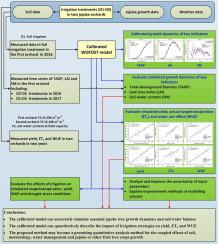当前位置:
X-MOL 学术
›
Agric. Water Manag.
›
论文详情
Our official English website, www.x-mol.net, welcomes your feedback! (Note: you will need to create a separate account there.)
Simulating on the effects of irrigation on jujube tree growth, evapotranspiration and water use based on crop growth model
Agricultural Water Management ( IF 6.7 ) Pub Date : 2021-01-01 , DOI: 10.1016/j.agwat.2020.106517 Tiecheng Bai , Nannan Zhang , Tao Wang , Desheng Wang , Caili Yu , Wenbo Meng , Hao Fei , Rengu Chen , Yanhui Li , Baoping Zhou
Agricultural Water Management ( IF 6.7 ) Pub Date : 2021-01-01 , DOI: 10.1016/j.agwat.2020.106517 Tiecheng Bai , Nannan Zhang , Tao Wang , Desheng Wang , Caili Yu , Wenbo Meng , Hao Fei , Rengu Chen , Yanhui Li , Baoping Zhou

|
Abstract Jujube is an excellent fruit crop with important economic and ecological benefits in arid regions. With the shortage of water resources, quantifying the jujube tree growth response to irrigation is significant for improving water use efficiency (WUE) and establishing adequate water management strategies. However, most studies on water management for jujube tree are based on statistical analysis of field trials to determine irrigation strategies, and few studies focus on using crop growth simulation methods to quantitatively analyze the impact of water management on jujube growth and WUE. Therefore, the research aimed at evaluating the ability of a calibrated WOFSOT (WOrld FOod Studies) model to simulate seasonal jujube tree development dynamics and water movement, and to quantitatively describe the influence of different irrigation treatments on yield, evapotranspiration and WUE. Simulated seasonal growth dynamics for total dry weight of stems, leaves and fruits (TAGP) and leaf area index (LAI) agreed well with field-measured values at each irrigation treatment in 2016 and 2017, showing R2 values from 0.92 to 0.98 for TAGP, 0.79 to 0.97 for LAI, with high accuracy (8.7 % ≤ NRMSE ≤ 20.5 % for TAGP, 8.1 % ≤ NRMSE ≤ 21.1 % for LAI). The calibrated model had also high global simulation performance of soil water balance process for all five irrigation treatments, showing good agreement (R2 ≥ 0.78) and low error (NRMSE ≤ 6.6 %). Simulated yield, actual evapotranspiration ( E T a ) and WUE in two orchards with different field capacity (FC) have also been confirmed to hold good agreement and high accuracy, and their R2 and NRMSE were 0.93 and 8.5 %, 0.80 and 3.6 %, 0.85 and 10.4 % at FC = 0.296 cm3 cm−3, 0.86 and 10 %, 0.62 and 5.8 %, 0.90 and 9.4 % at FC = 0.194 cm3 cm−3, respectively. In summary, the proposed method can quantitatively describe the impact of irrigation strategies on jujube tree seasonal growth dynamics, yield, evapotranspiration and WUE, which may become a promising quantitative analysis method for the coupled effects of soil, meteorology, water management and jujube tree growth, and decision-making for irrigation strategies.
中文翻译:

基于作物生长模型的灌溉对枣树生长、蒸散和水分利用影响的模拟
摘要 枣是干旱地区具有重要经济效益和生态效益的优良果品作物。在水资源短缺的情况下,量化枣树生长对灌溉的响应对于提高用水效率(WUE)和制定适当的水资源管理策略具有重要意义。然而,枣树水分管理的研究大多基于田间试验的统计分析来确定灌溉策略,很少有研究侧重于利用作物生长模拟方法定量分析水分管理对枣树生长和WUE的影响。因此,该研究旨在评估校准后的 WOFSOT(世界食品研究)模型模拟季节性枣树发育动态和水分运动的能力,定量描述不同灌溉处理对产量、蒸散量和 WUE 的影响。茎、叶和果实的总干重 (TAGP) 和叶面积指数 (LAI) 的模拟季节性生长动态与 2016 年和 2017 年每次灌溉处理的田间测量值非常吻合,显示 TAGP 的 R2 值从 0.92 到 0.98, LAI 为 0.79 至 0.97,精度高(TAGP 为 8.7 % ≤ NRMSE ≤ 20.5 %,LAI 为 8.1 % ≤ NRMSE ≤ 21.1 %)。校准模型对所有五种灌溉处理的土壤水平衡过程也具有较高的全局模拟性能,显示出良好的一致性(R2≥0.78)和低误差(NRMSE≤6.6%)。两个不同田间容量 (FC) 的果园的模拟产量、实际蒸散量 (ET a ) 和 WUE 也已被证实具有良好的一致性和高精度,并且它们的 R2 和 NRMSE 分别为 0.93 和 8.5 %、0.80 和 3.6 %、0.85 和 10.4 % 在 FC = 0.296 cm3 cm−3、0.86 和 10 %、0.62 和 5.8 %、0.43 和 19 cm−9 FC 时3、分别。综上所述,该方法可以定量描述灌溉策略对枣树季节性生长动态、产量、蒸散量和WUE的影响,有望成为一种很有前景的土壤、气象、水分管理和枣树生长耦合效应的定量分析方法。 ,以及灌溉策略的决策。
更新日期:2021-01-01
中文翻译:

基于作物生长模型的灌溉对枣树生长、蒸散和水分利用影响的模拟
摘要 枣是干旱地区具有重要经济效益和生态效益的优良果品作物。在水资源短缺的情况下,量化枣树生长对灌溉的响应对于提高用水效率(WUE)和制定适当的水资源管理策略具有重要意义。然而,枣树水分管理的研究大多基于田间试验的统计分析来确定灌溉策略,很少有研究侧重于利用作物生长模拟方法定量分析水分管理对枣树生长和WUE的影响。因此,该研究旨在评估校准后的 WOFSOT(世界食品研究)模型模拟季节性枣树发育动态和水分运动的能力,定量描述不同灌溉处理对产量、蒸散量和 WUE 的影响。茎、叶和果实的总干重 (TAGP) 和叶面积指数 (LAI) 的模拟季节性生长动态与 2016 年和 2017 年每次灌溉处理的田间测量值非常吻合,显示 TAGP 的 R2 值从 0.92 到 0.98, LAI 为 0.79 至 0.97,精度高(TAGP 为 8.7 % ≤ NRMSE ≤ 20.5 %,LAI 为 8.1 % ≤ NRMSE ≤ 21.1 %)。校准模型对所有五种灌溉处理的土壤水平衡过程也具有较高的全局模拟性能,显示出良好的一致性(R2≥0.78)和低误差(NRMSE≤6.6%)。两个不同田间容量 (FC) 的果园的模拟产量、实际蒸散量 (ET a ) 和 WUE 也已被证实具有良好的一致性和高精度,并且它们的 R2 和 NRMSE 分别为 0.93 和 8.5 %、0.80 和 3.6 %、0.85 和 10.4 % 在 FC = 0.296 cm3 cm−3、0.86 和 10 %、0.62 和 5.8 %、0.43 和 19 cm−9 FC 时3、分别。综上所述,该方法可以定量描述灌溉策略对枣树季节性生长动态、产量、蒸散量和WUE的影响,有望成为一种很有前景的土壤、气象、水分管理和枣树生长耦合效应的定量分析方法。 ,以及灌溉策略的决策。


























 京公网安备 11010802027423号
京公网安备 11010802027423号